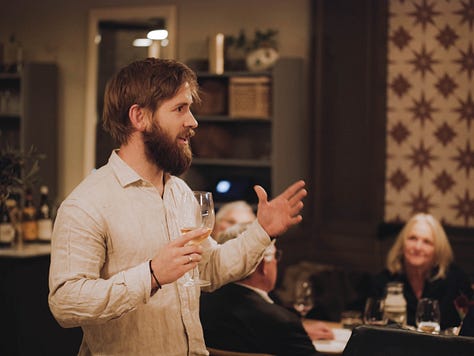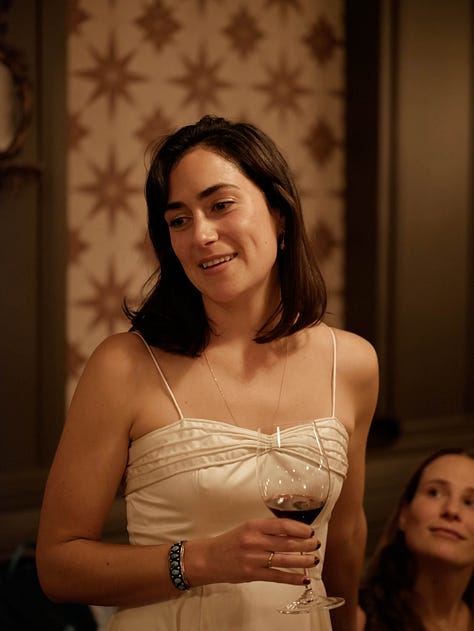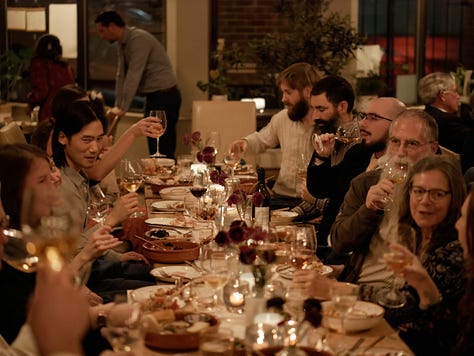The Lost Art of the Wedding Blessing
Don’t just invite guests to spectate. Invite them to participate.
Have you ever left a wedding feeling a little… déjà vu? Like, somehow despite the huge amount of money, planning, and flair, the whole ordeal was just another production?
There’s a lot to balance when planning for the most important day of a couple’s life. How can couples make it meaningful but not alienating, celebratory but not self-obsessed, with a structure that invites spontaneity?
I’ve noticed a common theme, every time I’ve helped couples plan their Big Day. I like to start by asking about who will be attending, and I always notice a hint of surprise in the brides-to-be, like they’ve been planning and thinking through about a million different details, but somehow the process hasn’t (until now) asked them about one of the most important parts of the party: the people coming.
Marriage is one of the most ancient and significant rituals known to man. It’s two people becoming one. Such a commitment is nothing short of radical, especially in a world marked by division and divorce. It will no doubt require a tremendous amount of sacrifice, self-denial and forgiveness. Is the best way to send a couple off into the gauntlet of life really with sparklers and late-night Taco Bell? (Apparently that’s a big trend for 2025 weddings).
Consider for a minute why couples invite others to their weddings. I think it’s because with a destiny-defining ceremony of such gravity, it’s important to bring others to witness and share in the joy. A wedding isn’t just a joining together of two people; it unites two tribes, who agree to support the couple in times of sickness and in times of health. It takes a village, indeed.
The Responsibility of the Guest Is to Bless
When planning for a wedding, it’s obvious that the couple has a lot of responsibilities. What’s almost always overlooked is the responsibility of the guests. Yes – each person present at the wedding has a responsibility to the couple, and not just to buy them a new blender.
Traditionally, part of the responsibility of witnessing a wedding was to bless the couple, explicitly or implicitly. Blessings usually came from elders, who had been around the block and knew a thing or two about the mysteries of marriage. Often the blessings took the form of ritualized words woven into the ceremony. One of my favorites is the Celtic blessing spoken while the couple’s hands were bound together (hence, ‘tying the knot’):
These are the hands that will work alongside yours, as together you build your future. These are the hands that will comfort you in grief and hold you in celebration. These are the hands that, even when wrinkled with age, will still reach for yours.
You can still see remnants of the pre-modern blessing rituals at even the most modern wedding today. It’s right there, in the wedding toasts – the part when those who intimately know the couple invite everyone else into the story. It’s when the beautifully ornamented setting, brought together by much effort and expense, meets with a heartfelt (even if light-hearted) narrative of what it all means. A great toast tells the story of how the couple converged, and blesses them as they begin their sojourn together on the sacred journey through life. Done right, wedding toasts can be earth-shaking, euphoric, even.
But today, toasts seem to be drifting away from their function to bless. And the consequences are not going unnoticed, especially by brides.
According to one, “I think toasts can be a really memorable and lovely part of a wedding if done correctly. With that said, I have definitely attended weddings where the toasts weren’t well-received, either due to being way too long, too full of inside jokes, or just really inappropriate.”
Another bride said, “I love [toasts] because it’s one of the personal and emotional highlights of the wedding – hearing from the parents, a sibling, or close friends is really neat. The thing is that you don’t want toasts to go on too long, or feature a never-ending slideshow, or make anyone uncomfortable.”
And another: “I’ve seen more and more brides on social media that are forgoing speeches entirely at their ceremony.”
How tragic! Rather than the pinnacle of the whole wedding, toasts are devolving into roasting, inside joking, and apparently PowerPoint presentations. If we’re not careful, they might just disappear. And then weddings will truly be nothing more than entertainment productions.
This might surprise you, but after participating in hundreds of Supra dinners, I can tell you that the problem is not that people don’t know how to make toasts. In fact, most people are really good at toasting, and they don’t need masters degrees in public speaking. What’s missing is the right environment.



This is what the Supra offers: A time-tested toasting tradition that fits the modern context. When folks see an example of a toast that comes from the heart; when someone besides them breaks the ice, then it’s easy to follow the pattern, and wedding toasts no longer run the risk of causing everyone to cringe.
The Supra Invites Blessings to the Wedding
A Supra dinner is facilitated by a ‘third player’ – the toastmaster, or ‘Tamada’. The Tamada brings an inspiring word that reminds people of the gravity of the occasion, and more importantly, has the perceptive ability to invite others to share words from their own hearts.
For a Supra, nobody needs to spend months sweating over a speech, or reading forums about the best ways to roast a groom or make people uncomfortable. The Supra’s structure invites spontaneity to the table, and therefore authenticity.
But the real reason a Supra transforms a wedding dinner party is because it sets forth participation guidelines. For example, the Tamada offers various themes of toasts over the course of a dinner. At a wedding Supra, you’re likely to hear a toast to the couple, to growth, to family, to humor, etc. After each of the Tamada’s toasts, guests are invited to offer their own toasts – with the requirement that their toasts must tie into the theme at hand. And that’s where the poetry happens; the limitations provoke creativity and depth.
Many of the toasts honor the close relatives and friends of the couple, who formed them and perhaps brought them together. For this reason, the Tamada, who is often a near-stranger, can invite everyone to honor the important people without spotlighting the attention on himself.
After a few toasts, guests catch on to the rhythm, and people begin offering words to the table – words that they actually mean, because they see that you don’t need to be an orator or comedian, to raise a glass and say something of significance. In the atmosphere of authenticity, people connect, feel, emote, share, embrace, mourn, and celebrate, as real human beings. Not everyone will make a toast at a Supra – that’s not the point. But often, some of the most profound words come from the ones you’d least expect.
A Supra is a way to celebrate a marriage that is actually worthy of the couple, the occasion, and the guests. It guarantees that a wedding is much more than just another expensive production. At a Supra, guests intuitively bless the newlyweds with words of wisdom and affirmation. And because guests participate in the wedding, and offer something real to the new couple, the guests themselves leave the wedding filled, abounding in joy for the new family.
As for the newlyweds, they begin their life journey knowing that they’re not alone in their quest of growing in love. They have family, friends and a community who will continue to celebrate with them in their victories, and uplift them in times of struggle, because the newlyweds honored their guests with such a profound joining of hearts.
We can bring the Supra to you, anywhere in the United States. It’s the perfect way to celebrate an engagement party, rehearsal dinner, or small reception. For wedding Supras, we recommend between 10 and 50 guests.







